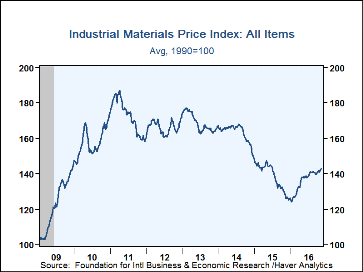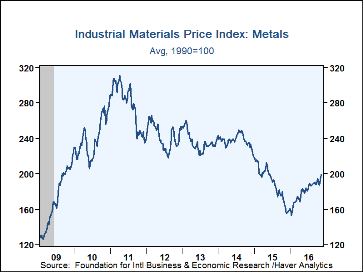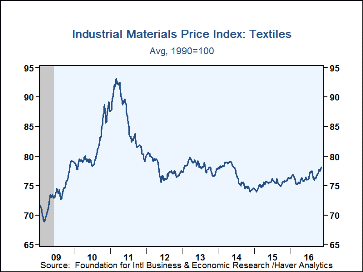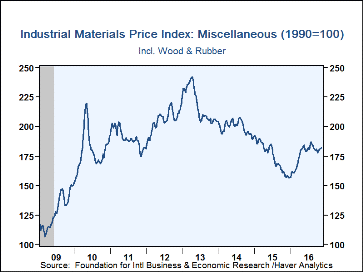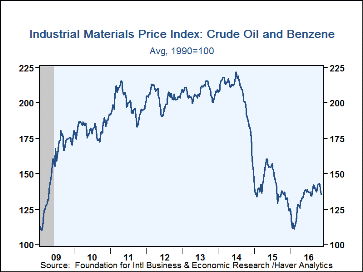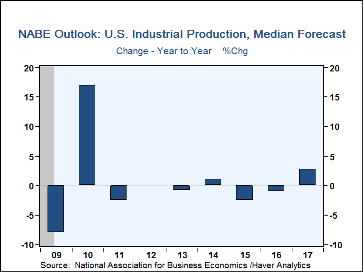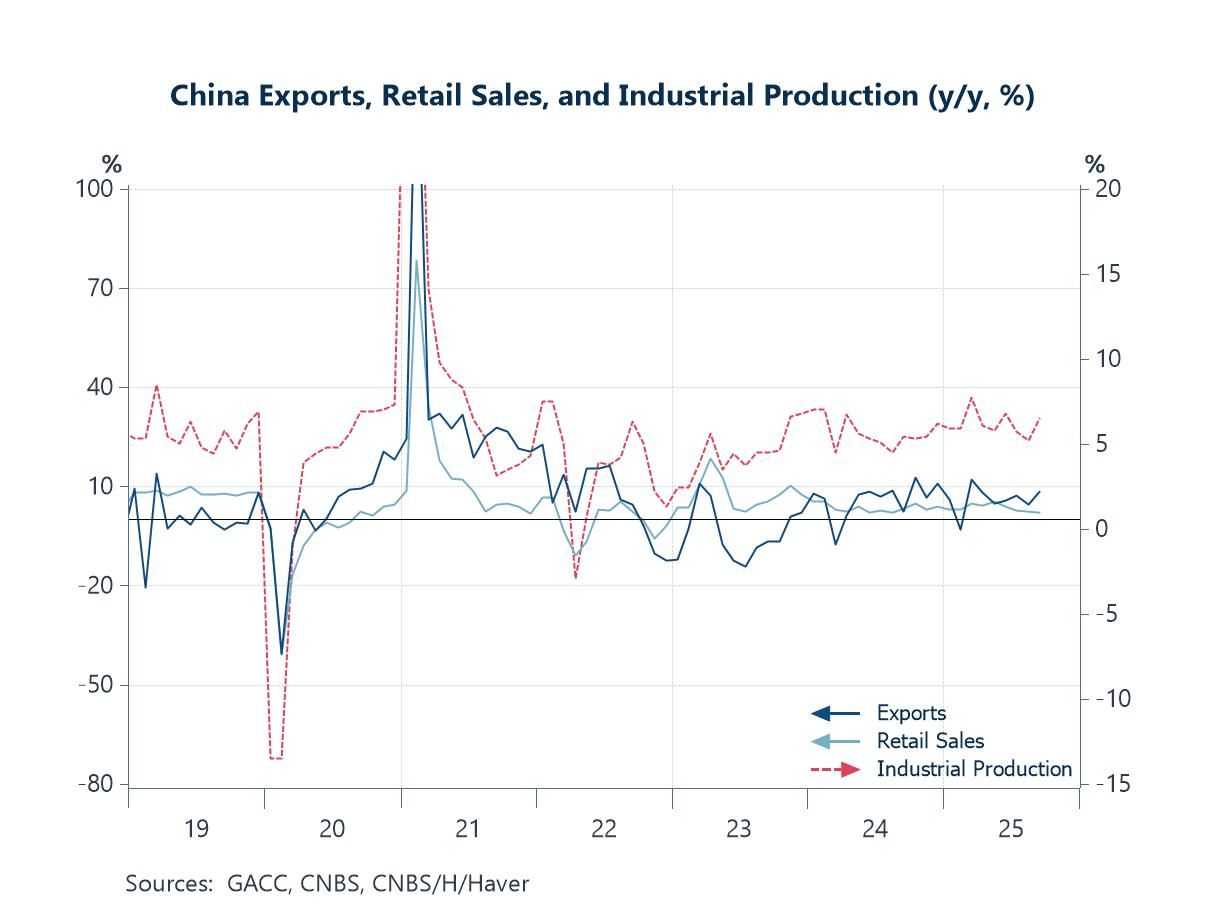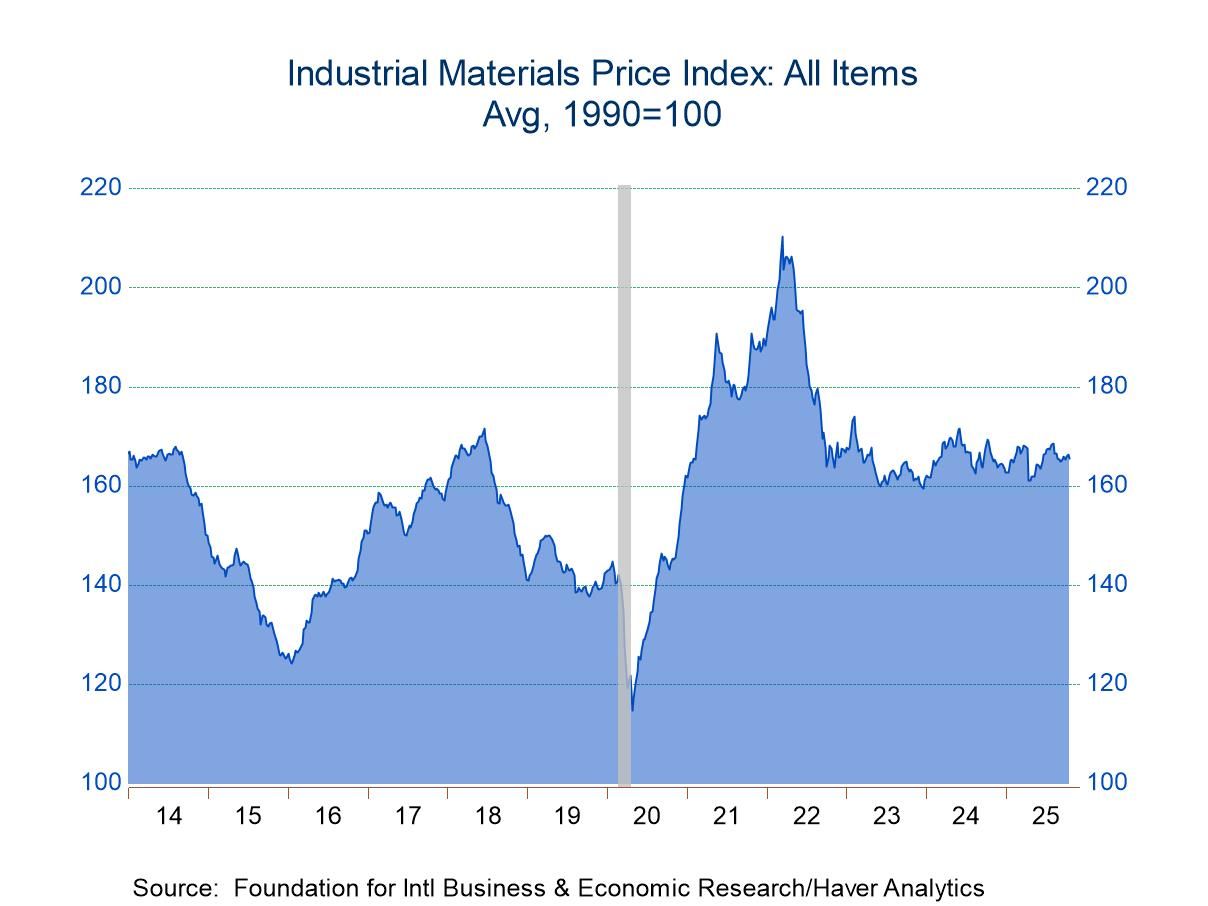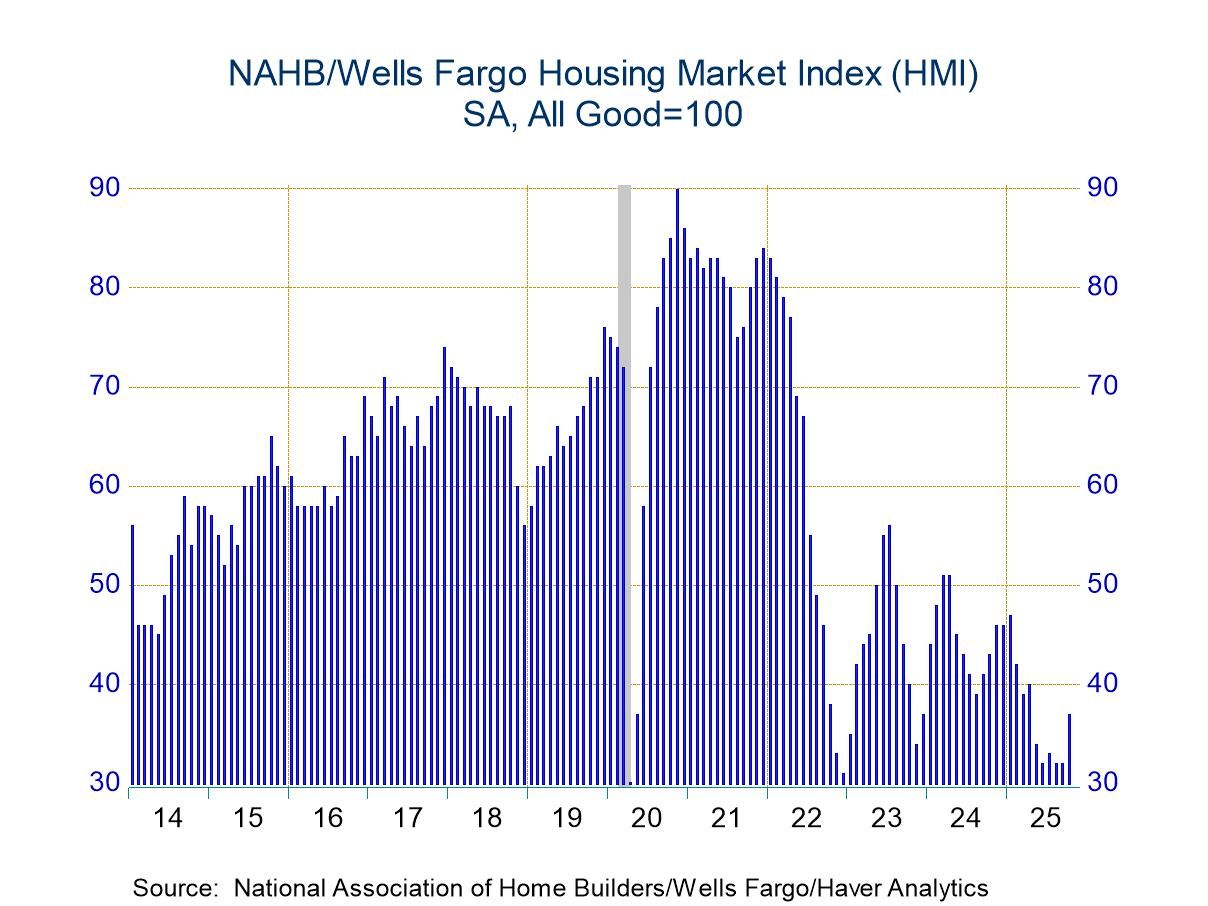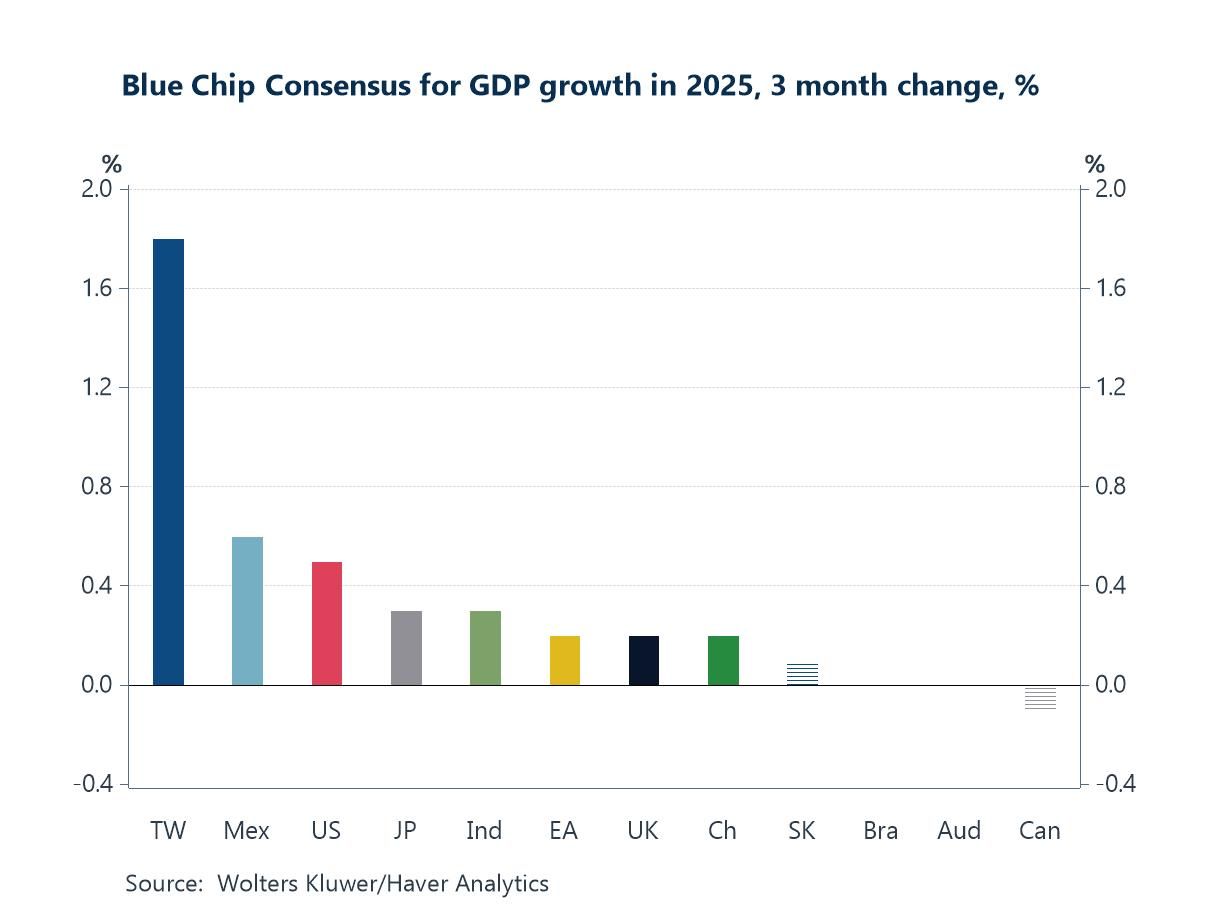 Global| Nov 14 2016
Global| Nov 14 2016FIBER: Industrial Commodity Prices Strengthen
by:Tom Moeller
|in:Economy in Brief
Summary
Modest improvement in U.S. factory sector activity is lending support to industrial commodity prices. Since December, manufacturing sector production has been roughly unchanged following last year's 0.3% decline from December-to- [...]
Modest improvement in U.S. factory sector activity is lending support to industrial commodity prices. Since December, manufacturing sector production has been roughly unchanged following last year's 0.3% decline from December-to-December. The Industrial Materials Price Index from the Foundation for International Business and Economic Research (FIBER) eased 1.0% during the last four weeks, but has risen 11.6% during the last twelve months, after sharp declines from 2012 to 2015.
Within the sector groupings of prices, the FIBER indexes showed increases in several categories. Within the metals sector, prices rose 3.6% last month, and by nearly one quarter y/y. Copper scrap prices moved 8.0% higher during the last three months, and by 5.1% y/y. Aluminum prices similarly strengthened 5.8% during that period, and by 15.9% y/y. Zinc prices improved by more than one-third y/y. Steel scrap prices, however, remained under pressure. They have declined 14.4% during the last three months, but they're up 15.8% y/y. In the textile group, cotton prices moved 5.4% lower during the last three months, but were 12 .6% higher versus last year. Showing more strength were burlap prices which jumped 9.2% during the last month, making up for declines since last April. In the miscellaneous group, the recent softening of activity in home building activity left framing lumber prices down 6.0% during the last three months, but they're still up 4.2% y/y. Prices for structural panels have been similarly under pressure. Natural rubber prices were recovering sharply earlier this year, but have been moving sideways since April. Crude oil & benzene costs have been moving erratically sideways since June. WTI crude oil costs recently fell below $44 per barrel after nearing $50 in June. Prices for the petro-chemical benzene have moved irregularly sideways since early last year, but were down by half since the 2014 peak.
Further support for industrial commodity prices may be forthcoming. The current industrial output projection from the National Association for Business Economics (NABE) calls for a 2.0% increase in production during all of 2017, following a 0.7% decline this year. During the last ten years, there has been a 52% correlation between the three-month change in prices and the change in U.S. industrial output. In addition, moderate growth in factory sector production world wide is continuing.
Commodity price data can be found in Haver's DAILY, WEEKLY, USECON and CMDTY databases. The NABE forecast is in the SURVEYS database.
Inflation and Japan's Ever-Tightening Labor Market from the Federal Reserve Bank of New York can be found here.
| FIBER Industrial Materials Price Index | 1-Mth % | 3-Mth % | 6-Mth % | 12-Mth % | 2015 % | 2014 % | 2013 % |
|---|---|---|---|---|---|---|---|
| All Items | 1.0 | 1.5 | 3.8 | 11.6 | -16.3 | -10.0 | -2.9 |
| Textiles | 1.2 | 1.0 | 3.2 | 3.3 | 2.2 | -4.2 | 0.4 |
| Cotton (cents per pound) | 1.8 | -5.4 | 14.8 | 12.6 | 2.6 | -24.2 | 10.8 |
| Metals | 3.6 | 6.3 | 11.0 | 22.8 | -27.8 | -8.7 | -3.5 |
| Aluminum ($ per metric ton) | 3.1 | 5.8 | 10.8 | 15.9 | -19.2 | 9.4 | -15.8 |
| Copper Scrap (cents per pound) | 8.7 | 8.0 | 9.4 | 5.1 | -27.0 | -12.0 | -6.8 |
| Steel Scrap ($ per ton) | -8.0 | -14.4 | -19.2 | 15.8 | -53.8 | -18.6 | 8.4 |
| Crude Oil & Benzene | -4.9 | -1.0 | 1.1 | 1.2 | -19.4 | -26.5 | 0.8 |
| Crude Oil (WTI, $ per Barrel) | -12.1 | 4.6 | -1.6 | 2.4 | -35.8 | -43.2 | 10.3 |
| Miscellaneous | 1.5 | -1.1 | -0.7 | 14.6 | -18.0 | -6.7 | -6.8 |
| Framing Lumber ($ per 1000 board ft.) | -3.6 | -6.0 | -2.3 | 4.2 | -16.4 | -1.6 | 3.5 |
| Natural Rubber (cents per pound) | 5.3 | 4.4 | -1.1 | 45.3 | -22.5 | -32.3 | -9.8 |
Tom Moeller
AuthorMore in Author Profile »Prior to joining Haver Analytics in 2000, Mr. Moeller worked as the Economist at Chancellor Capital Management from 1985 to 1999. There, he developed comprehensive economic forecasts and interpreted economic data for equity and fixed income portfolio managers. Also at Chancellor, Mr. Moeller worked as an equity analyst and was responsible for researching and rating companies in the economically sensitive automobile and housing industries for investment in Chancellor’s equity portfolio. Prior to joining Chancellor, Mr. Moeller was an Economist at Citibank from 1979 to 1984. He also analyzed pricing behavior in the metals industry for the Council on Wage and Price Stability in Washington, D.C. In 1999, Mr. Moeller received the award for most accurate forecast from the Forecasters' Club of New York. From 1990 to 1992 he was President of the New York Association for Business Economists. Mr. Moeller earned an M.B.A. in Finance from Fordham University, where he graduated in 1987. He holds a Bachelor of Arts in Economics from George Washington University.


